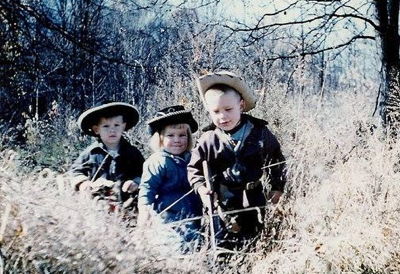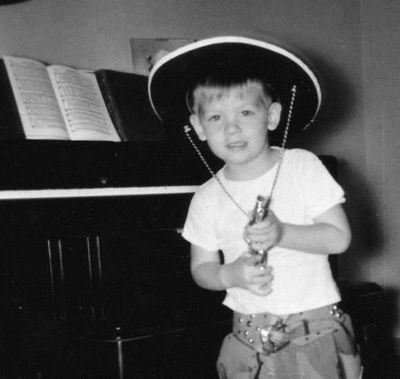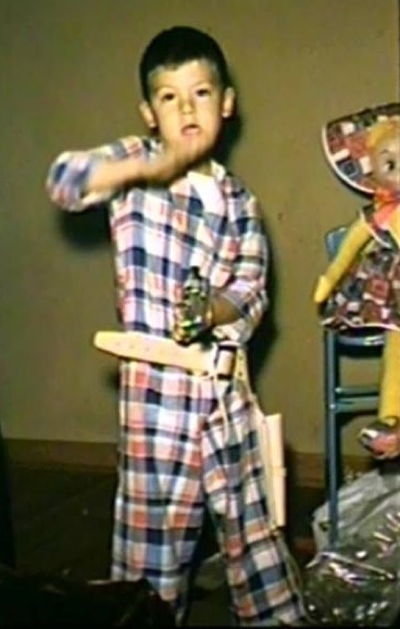
The following article by David Strange was originally published on 4 Sep 2016.





I vividly remember back when I was a little boy, waiting anxiously for the weekly TV showing of "Gunsmoke." Without fail, I was always ready and waiting, as the entire family settled in to watch. I stood there in front of the TV staring intensely at the screen, six-shooter loosely set in my artificial-leather holster, fingers flexing restlessly over the gun handle, and black cowboy hat slung low over my brow, ready to do battle. In those years, Gunsmoke always opened with Marshal Matt Dillon standing in the center of the street, grimly looking directly at the camera, facing down an unseen opponent in a gunfight…waiting for the draw. When Dillon pulled his gun and fired, I'd jump back dramatically and fall on the floor, "dead." The family always laughed appreciatively.
There was a time, not so long ago, that seems almost inconceivable in this modern day of terrorism and almost daily real shootings, when "shooting" at each other was considered unquestionable fun.
It was a time, a time of my youth in the 1950's and early 60's, when boys and girls would run around the neighborhood innocently playing "Cowboys & Indians," "War," and "Cops & Robbers."
I think nearly every boy had at least one "six-shooter" and holster, and knew how to draw it like Matt Dillon or "Have Gun, Will Travel's" Paladin. Every child had a wooden bow, even if made from stick and string, and an arrow with rubber suction-cup tip. Every child knew Hopalong Cassidy (I still have a Hopalong Cassidy watch), Gene Autry, The Lone Ranger, Brave Eagle, and Roy Rogers & Dale Evans. Then there was Bat Masterson, Bonanza, Branded, Broken Arrow, Laramie, Wyatt Earp, Rawhide, The Rifleman, Wagon Train, and so many others.
I think I wore out three sets of toy guns, myself. But if a kid didn't have a toy gun, it really didn't matter. A simple well-chosen stick would do. A long stick could do double duty as either a rifle or a horse, depending on the need. If you were on a farm and didn't have a real toy stick horse with "genuine vinyl" horse head, a tobacco stick was fine.
In my community, there were six of us boys, rampaging through the neighborhood, running around houses, hiding in bushes, and probably driving grownups crazy with our screams and rebel yells in our mixed up storyline of Civil War, Cowboys & Indians, and even World War II all at the same time. Come to think of it, though, I don't remember hearing even one complaint; we never did any intentional harm to any property; we were just playing together.
Kathy Pahlman reminds me that the games weren't just for boys. "We all played Cowboys & Indians. Didn't every little girl want to be Dale Evans? They always got the bad guys and taught us to be honest and truthful. The Lone Ranger and Tonto proved that even if someone was different, they had value."
As the boys in my neighborhood got a little older and the TV show "Combat!" became popular, we switched to playing WWII soldiers. We would take turns being Germans and Americans, hiding behind bushes and sneaking around neighbors' yards, guns blazing away as we teamed up against one another. My favorite toy at that time was an official green plastic Tommy-gun just like Sgt. Saunders (actor Vic Morrow) carried, that could shoot a whole roll of caps with one pull of the trigger.
It was a time of childhood innocence of otherwise very serious things, but it also fostered life-long friendships. Cowboys and Indians certainly fostered stereotypes as well, but somehow seemed as innocent as playing Hide and Seek.
I don't know, but I can hardly imagine such gun games being played today, at least in the way they were then. Sadly, the almost-daily reality of all-too-real guns has changed the discussion and the perception.
Mike Hostettler and others have told me that the local child-cowboy-and-birthday show, "T-Bar-V," stopped having its feature gun-draw moment, in which kids could "fast-draw" their gun, for a while in the 1960's. They say that the TV station owners, the Bingham family, thought having the kids draw their guns was sending the wrong message following the killing of President Kennedy. Then there was another shooting, and another.
At about the same time, people were beginning to become more aware of the stereotyping of Native Americans and other minorities. TV westerns began focusing on improved, and more inclusive, storytelling rather than focusing on gunfights. Even "Gunsmoke" quit using its iconic gunfight opening scene. Somewhere along the way, as a young man, I noticed that it became almost impossible to find a toy gun in a store. Some eventually reappeared, but had been changed to meet new laws requiring toy guns to not look real. Then came mass shootings and terrorism. And recently a boy was killed because police believed the toy gun he was carrying was a real threat.
Oh, kids still play "shoot-em-up," but mostly they do it today on computer games. Friend, Gary Karr, wonders if stopping kid's from playing with toy guns is a big part of our problem today. "I grew up doing exactly the same thing.," he says, "As a result we respected real firearms. We saw the ones used for hunting and the occasional putting down an animal on the farm. Nowadays kids play video games where if you die you bounce back a few minutes later and start all over again. If a bad guy was killed in a Western we watched, that character was never on the same show again. We had a lot of fun and good times playing with those roles. I think we may have even learned a few life skills from them. It was innocent and fun."
Real folks and politicians constantly debate what is right and what is wrong. Who am I to say? Right or wrong, we are always learning. We are the sum of our experiences. All I can say is that some of my fondest memories are from those carefree days of childhood, playing Cowboys and Indians with my friends.
Copyright 2016 by David Strange, Shepherdsville KY. All rights are reserved. No part of the content of this page may be included in any format in any place without the written permission of the copyright holder.
The Bullitt County History Museum, a service of the Bullitt County Genealogical Society, is located in the county courthouse at 300 South Buckman Street (Highway 61) in Shepherdsville, Kentucky. The museum, along with its research room, is open 10 a.m. to 4 p.m. Monday through Friday. Saturday appointments are available by calling 502-921-0161 during our regular weekday hours. Admission is free. The museum, as part of the Bullitt County Genealogical Society, is a 501(c)3 tax exempt organization and is classified as a 509(a)2 public charity. Contributions and bequests are deductible under section 2055, 2106, or 2522 of the Internal Revenue Code. Page last modified: 13 Jan 2024 . Page URL: bullittcountyhistory.org/memories/cowboys.html